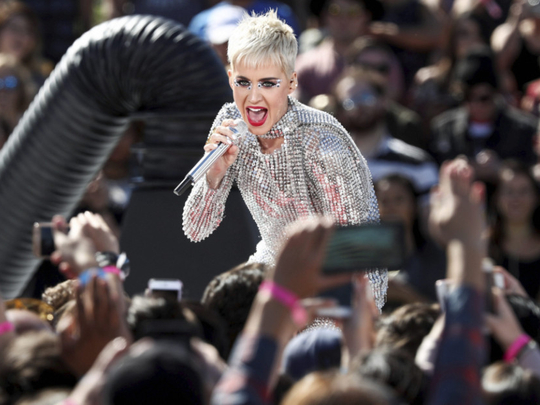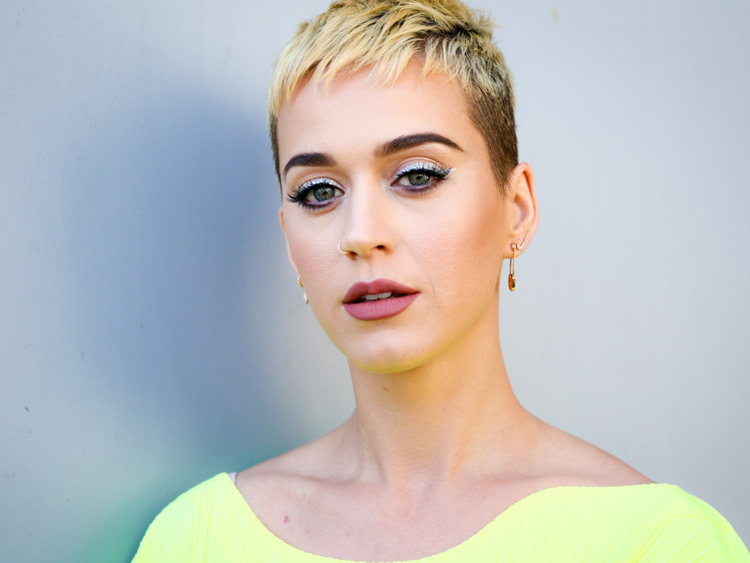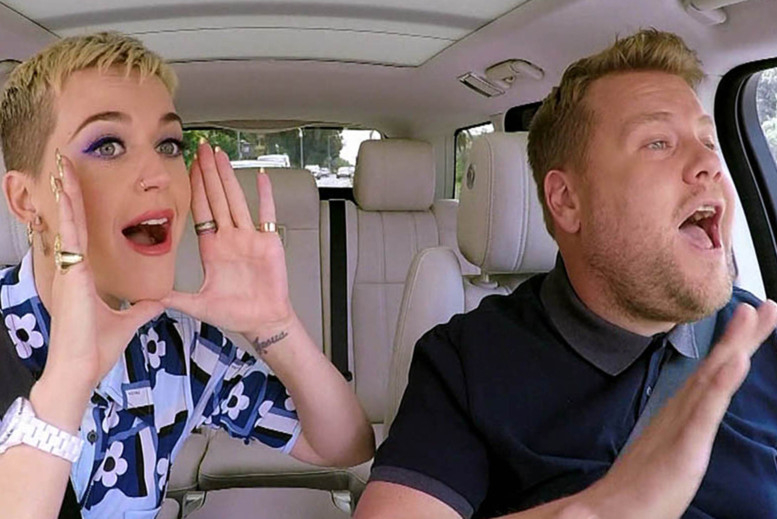
A dizzying array of police lights flashed up and down the West Side Highway on a damp Thursday in May. President Donald Trump was visiting the USS Intrepid, snarling traffic outside the Javits Convention Center, where Katy Perry was performing at a corporate showcase for her new partner, YouTube. The last time she was in the building was election night, when she had been preparing to toast the victory of Trump’s opponent.
For Perry, who prominently supported Hillary Clinton’s campaign, that party on November 8 began “with everybody looking fancy and beautiful and high on their horses,” she recalled in an interview several weeks after her YouTube set. The mood rapidly shifted when word started to spread that Clinton was not on her way there — news that Perry, 32, described as “traumatising.”
“It was a revelation, it was a reckoning,” she said of Clinton’s loss. She started downing drinks and reached out to the nearest person for physical support: Lady Gaga, also there to celebrate the election of the first female president. There they were, “Gaga and I just looking at each other and being like, [expletive] it, we need to touch each other,” Perry said. And for a minute, two of the biggest pop stars in the world held hands.
Alliances aren’t easily made in the superstar stratosphere, where elbows are often sharp. And Perry, who released her fourth major label album, Witness, on June 9, stands as one of the biggest successes in the industry, alongside Madonna, Beyonce and Taylor Swift. She has sold 6.5 million albums and nearly 71 million digital songs in the United States, according to Nielsen Music; notched 14 Top 10 Billboard Hot 100 hits; performed at the 2015 Super Bowl halftime show; and landed a gig as a judge on the revamped American Idol, which is to return in September on ABC.
But she said she had an awakening on election night tied to misogyny in her past. And she is undertaking a strenuous effort to prove she isn’t the same frothy Katy Perry as before, making over her look, her music and her vocabulary. For 96 hours, timed to the album’s release, she spread that message of “unity and communication” via filibuster — a non-stop YouTube live stream called Witness World Wide, organised into segments (a therapy session, meditations, a cathartic chat with RuPaul) where the words “safe place” came up a lot and Perry worked out to her own album.
Thanks to Madonna’s restlessness, female pop stars are expected to reinvent themselves every few years, but there’s no guarantee that listeners will accept the changes. For Perry, the stakes couldn’t be higher: She believes she is now revealing her true self. The old Katy Perry is gone.
“Every day when I think I know something, the universe shows me that I need to learn another lesson,” she told me in a Manhattan shared workspace. “So I stand here today, more so than any other day, saying I know nothing. I literally know nothing.” (Perry often veers into platitudes, but she is consistent: During the live stream, she wore an “I Know Nothing” T-shirt for yoga, and the phrase is currently her Twitter bio.)
“I feel very empowered,” she continued, “extremely liberated, liberated from the conditioning of the way I used to think, spiritually liberated, politically liberated, sexually liberated, liberated from things that don’t serve me.”
She said she stopped drinking (for now) on January 15, and she has been attending group therapy with her family. Her parents are Pentecostal pastors, and Perry, who was born Katheryn Hudson, was raised in a strict religious tradition. “I went to that dark place that I had been avoiding, and I dug out the mold,” she said. “It was not fun, but I did that — I’m still doing that.”
Change is also the theme of the throbbing Witness, an introspective, less pop-driven album that’s a departure from her last two records, Prism (2013) and Teenage Dream (2010). It’s her first LP not to feature work from her longtime collaborator Dr. Luke — “I had to leave the nest,” she said; he declined to comment for this article — although she continued her partnership with Swedish hit maker Max Martin.
And she assumed even greater creative control, helping bring in producers like indie-pop duo Purity Ring, composer Dustin O’Halloran (the theme from Amazon’s Transparent) and English musician Jack Garratt to create a palette that’s dreamy and clubby, if not as grabby as her earlier records. Perry has always been known as a reliable singles artist, but reviews haven’t been friendly. The album’s most successful single, Chained to the Rhythm, peaked at No. 4.
Perry told me she didn’t play her new music for Capitol Records, her label, until a few weeks before our interview, which is late in the process. If the label minded, it isn’t saying so. “I like to allow her the freedom to keep pursuing her artistic vision, and obviously we support her fully in all her endeavours,” said Steve Barnett, the chairman and chief executive of the Capitol Music Group, adding that choices about her sound and team were Perry’s call: “I think she’s earned and deserved that.”
The person charged with helping create Perry’s vision was Lauren Glucksman, 28, who is credited with A&R on the album, stepping into this role for the first time on a full LP. (She formerly worked as an assistant to singer Ellie Goulding and managed songwriter Banks.) “We have a very honest rapport with each other, we have very similar taste, and ultimately I saw my job as trying to translate what’s in her mind and in her heart,” Glucksman said. Both women were listening to a lot of electronic pop, and the way Perry explained it, she decided, “I’m going to stop making a playlist and just be the playlist.”
In the knotty world of internet superfandom, the harshest takes often come from deep inside an artist’s nucleus of support. Fans were so concerned about Perry’s shifts on Witness, they lasered in on Glucksman and demanded her ouster from the inner circle. (“#FireLauren,” tweeted one particularly vociferous account.)
“People don’t let people grow,” Perry said. “They just want a time capsule. And they want them to be one thing. And we have to start re-imagining that.”
Perry doesn’t need to live in a house outfitted with 41 Big Brother-style cameras to be aware that she is under constant surveillance. She has a well-known strategy for frustrating the paparazzi (wearing the same Adidas track suit when she leaves home to make the photographs less sellable), but that can’t stop the kind of gawking that accompanies daily life when you’re trading punches with another wildly famous blond pop star or dating a famous actor who enjoys nude paddleboarding. When she took up a vocal position as a Clinton supporter, she became a target of the alt-right. But as she started revving up for Witness, it felt like some on the left were also taking their knives out.
Over the years, Perry has absorbed criticism for cultural appropriation, for being too sexy on Sesame Street, for dating John Mayer. But in the past few months, the somewhat erratic nature of her album roll-out (a long string of ideas that didn’t quite land, like serving her head on a platter as part of an “art installation” at the Whitney Museum of American Art) dripped blood in the water. And the sharks — not the adorably inept Left Shark at the Super Bowl — started circling.
Reacting to a steady stream of criticism (TMZ’s Met Ball headline: “Katy Perry Rocks Ugly Outfit by Jew-Hating Designer”) is a “maddening game,” she said. Referring to what she called “this strange race to be the most woke,” she added, “They want you to stand for something, but once you do, and if you don’t do it perfectly, they’re ready to take you right down.”
It didn’t take long for the outrage machine to ramp up in real time. Three days before our interview, Perry greeted me in her dressing room at Saturday Night Live, where she was performing on the season finale, and interrogated me with questions while maintaining some of the most penetrating eye contact I’ve experienced outside of an ophthalmologist’s chair, her already wide eyes blazing under heavy swooshes of silver glitter.
On the show, she strutted to her latest single, Swish Swish, with a group of drag queens and posed on a banquet table to “Bon AppEtit” with Atlanta rap trio Migos. Then she spent an hour getting reglammed for the after-party; snuggled her micro teacup poodle, Nugget; and marched through an underground parking garage, pausing at a vending machine to buy a bag of Cool Ranch Doritos. At the party, she was easy to spot on the dance floor, throwing down beside Leslie Jones to Jessie J’s Bang Bang and Bruno Mars’ That’s What I Like — you just had to look for all the cell phones in the air, capturing her every move.
“SO. FUN,” Perry tweeted about the show to her nearly 100 million followers, adding a shout-out “to my LGBTQ family, all the Queens & @Migos for showing unity & respect.” But the internet had already cited her for several violations, including appropriating gay culture and purportedly reducing the number of drag queens onstage to placate Migos, which, in her critics’ minds, made her the villain.
“Intention is everything,” Perry told me, repeating one of her mantras. “All I was trying to do is build a bridge.”
But Perry bears some responsibility for stoking fires. A chunk of promotional efforts for Witness leant on the headline-generating magic of a feud: On Carpool Karaoke, she confirmed that Swish Swish is about her 3-year-old rift with Taylor Swift. Swift struck back by returning her catalogue to streaming services at the same minute Witness was released. For all of Perry’s talk about feminism and unity, it felt like a conventional catfight. But by the time of her live stream, she softened her position. When she performed the song at the Witness World Wide finale, she changed the lyric “Don’t you come for me” to “God bless you on your journey.”
To appreciate how Perry arrived at Witness, you have to understand her relationship to her biggest album, Teenage Dream. It had five No. 1 hits, tying a record Michael Jackson set with Bad, and solidified her image as a charmingly goofy sexpot who sings about love, partying and inner strength. Her breezy persona belied the gruelling work that went into touring, radio promotion and being the linchpin of a multimillion-dollar extravaganza.
The 2012 tour documentary Katy Perry: Part of Me captured a glimpse of the rigours: Her marriage to comedian Russell Brand was crumbling as the burdens of becoming a superstar mounted. “I was just kind of like a deer in headlights a little bit,” she said. “I was like, does this happen to people? Like, is this normal?
“When people are just talking about Teenage Dream, I’m like, please talk to me when you’ve done that. And lived through it. Because it was [expletive] intense. And amazing and beautiful and horrible all at the same time.”
Part of the pressure stemmed from maintaining her hypersexual image, which Perry takes responsibility for helping create. “I used to be scared of intimacy, I used to use my sexualisation as attention, I used to oversexualize myself because that was the only way I knew how,” she said. (Perry, who hit No. 1 with I Kissed a Girl, later explained why she holds queer women in high esteem: “I admire that they’re doing it for themselves. They are not doing it for the male gaze.”) It’s easy to read her drastic haircut and new stylistic choices — her live stream finale outfit covered her in neck-to-toe sequins — as a reaction to having worn whipped-cream bras in the past.
Perry credits her shift in perspective on her sexuality — she calls it “a full sexual liberation” — to resolving issues with her father. “The reality is that I was retriggered on the election,” she said. “I was retriggered by a big male that didn’t see women as equal. And that had been, unfortunately, a common theme in my upbringing.”
Sexism is also widespread in the music industry, where in the past year harassment and assault claims have been levelled at every echelon — top executives like L.A. Reid, creative powerhouses like Dr. Luke, indie rock bands like PWR BTTM.
When she needs to speak with somebody who can relate, Perry said she turns to Sia, a songwriter and artist who has gone to great lengths to control how much (or in her case, how little) the public sees of her inner life. “I think she’s presently challenging old held beliefs about herself and that even in this day and age, cutting all your hair off and having an opinion is NOT WHAT THE PEOPLE WANT,” Sia wrote in an email message. “They would prefer you to make cute pop and to stay in your lane.” She added: “I hide behind my wig, while she is out there taking bullets for the rest of us ... The less brave ... you know?”
The Katy Perry viewers watched on Witness World Wide is the Katy Perry I spent several days with: gregarious, intense, bold, endearing and full of contradictions.
In our interview, she proclaimed herself devoted to dialogue but spoke in a near uninterrupted monologue. She griped frequently about the internet (the Wild Wild West, a quip she repeated on the live stream nearly every time I tuned in), but she boasts the highest number of Twitter followers of any user and just allowed her digital audience to watch her eat, sleep and spread her new gospel on a 96-hour infomercial. She returned to words and phrases: good things are “beautiful”; a desirable mate is “a man of quality and equality” (and for the record, she said Orlando Bloom was one, and Mayer and even Brand “are beautiful in their own right”). And she revisited a pet subject: things that are “not real.”
“All the awards shows are fake,” she said, “and all the awards that I’ve won are fake,” she added, explaining that they don’t represent the audience. “They’re constructs.”
The old Katy Perry wasn’t a construct, she explained, and she isn’t dead. “I didn’t kill her, because I love her, and she is exactly what I had to do then,” she said. “And I’m not a con artist, I didn’t con people, like, that was just me. And this is me now.”
Perry’s awakening has been tapped as a marketing strategy for Witness, and the live stream was selling her authenticity: If you dig hearing about her new perspective, maybe you’ll enjoy her song Power. While there are still plenty of relationship songs on Witness that will have fans wondering which of her beaus she misses more than she loved, seven tracks deal plainly with her new mindset. The most direct is Bigger Than Me, a statement of purpose akin to Michael Jackson’s Man in the Mirror (“But my intuition says there’s a bigger mission I must embrace/So I’m, I’m pushing my thoughts to a new place”).
Although some of the subject matter is thorny and emotional, Glucksman described the making of Witness as “the most joyful professional process I have ever experienced.” And Perry said she’s the happiest she’s ever been.
“It’s a departure, and it’s a necessary evolution that I have to take,” Perry said. “And I know that sometimes it feels publicly like I’m dragging concrete blocks, but like, the pyramids were made out of concrete blocks — or not cement. But do you know what I’m trying to say? I’m gonna get there.”















